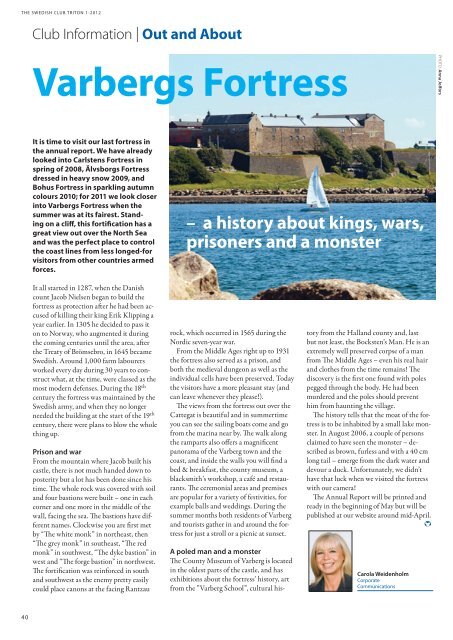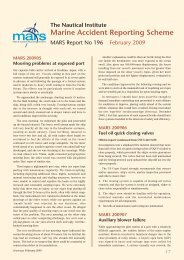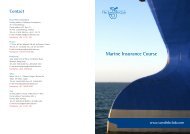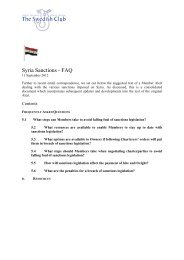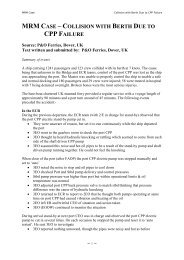TSC Triton no. 1 2012 - The Swedish Club
TSC Triton no. 1 2012 - The Swedish Club
TSC Triton no. 1 2012 - The Swedish Club
- No tags were found...
Create successful ePaper yourself
Turn your PDF publications into a flip-book with our unique Google optimized e-Paper software.
THE SWEDISH CLUB TRITON 1-<strong>2012</strong><strong>Club</strong> Information | Out and AboutVarbergs FortressPhoto: Anna JolforsIt is time to visit our last fortress inthe annual report. We have alreadylooked into Carlstens Fortress inspring of 2008, Älvsborgs Fortressdressed in heavy s<strong>no</strong>w 2009, andBohus Fortress in sparkling autumncolours 2010; for 2011 we look closerinto Varbergs Fortress when thesummer was at its fairest. Standingon a cliff, this fortification has agreat view out over the North Seaand was the perfect place to controlthe coast lines from less longed-forvisitors from other countries armedforces.– a history about kings, wars,prisoners and a monsterIt all started in 1287, when the Danishcount Jacob Nielsen began to build thefortress as protection after he had been accusedof killing their king Erik Klipping ayear earlier. In 1305 he decided to pass iton to Norway, who augmented it duringthe coming centuries until the area, afterthe Treaty of Brömsebro, in 1645 became<strong>Swedish</strong>. Around 1,000 farm labourersworked every day during 30 years to constructwhat, at the time, were classed as themost modern defenses. During the 18 thcentury the fortress was maintained by the<strong>Swedish</strong> army, and when they <strong>no</strong> longerneeded the building at the start of the 19 thcentury, there were plans to blow the wholething up.Prison and warFrom the mountain where Jacob built hiscastle, there is <strong>no</strong>t much handed down toposterity but a lot has been done since histime. <strong>The</strong> whole rock was covered with soiland four bastions were built – one in eachcorner and one more in the middle of thewall, facing the sea. <strong>The</strong> bastions have differentnames. Clockwise you are first metby “<strong>The</strong> white monk” in <strong>no</strong>rtheast, then“<strong>The</strong> grey monk” in southeast, “<strong>The</strong> redmonk” in southwest, “<strong>The</strong> dyke bastion” inwest and “<strong>The</strong> forge bastion” in <strong>no</strong>rthwest.<strong>The</strong> fortification was reinforced in southand southwest as the enemy pretty easilycould place ca<strong>no</strong>ns at the facing Rantzaurock, which occurred in 1565 during theNordic seven-year war.From the Middle Ages right up to 1931the fortress also served as a prison, andboth the medieval dungeon as well as theindividual cells have been preserved. Todaythe visitors have a more pleasant stay (andcan leave whenever they please!).<strong>The</strong> views from the fortress out over theCattegat is beautiful and in summertimeyou can see the sailing boats come and gofrom the marina near by. <strong>The</strong> walk alongthe ramparts also offers a magnificentpa<strong>no</strong>rama of the Varberg town and thecoast, and inside the walls you will find abed & breakfast, the county museum, ablacksmith’s workshop, a café and restaurants.<strong>The</strong> ceremonial areas and premisesare popular for a variety of festivities, forexample balls and weddings. During thesummer months both residents of Varbergand tourists gather in and around the fortressfor just a stroll or a picnic at sunset.A poled man and a monster<strong>The</strong> County Museum of Varberg is locatedin the oldest parts of the castle, and hasexhibitions about the fortress’ history, artfrom the ”Varberg School”, cultural historyfrom the Halland county and, lastbut <strong>no</strong>t least, the Bocksten’s Man. He is anextremely well preserved corpse of a manfrom <strong>The</strong> Middle Ages – even his real hairand clothes from the time remains! <strong>The</strong>discovery is the first one found with polespegged through the body. He had beenmurdered and the poles should preventhim from haunting the village.<strong>The</strong> history tells that the moat of the fortressis to be inhabited by a small lake monster.In August 2006, a couple of personsclaimed to have seen the monster – describedas brown, furless and with a 40 cmlong tail – emerge from the dark water anddevour a duck. Unfortunately, we didn’thave that luck when we visited the fortresswith our camera!<strong>The</strong> Annual Report will be printed andready in the beginning of May but will bepublished at our website around mid-April.Carola WeidenholmCorporateCommunications40


